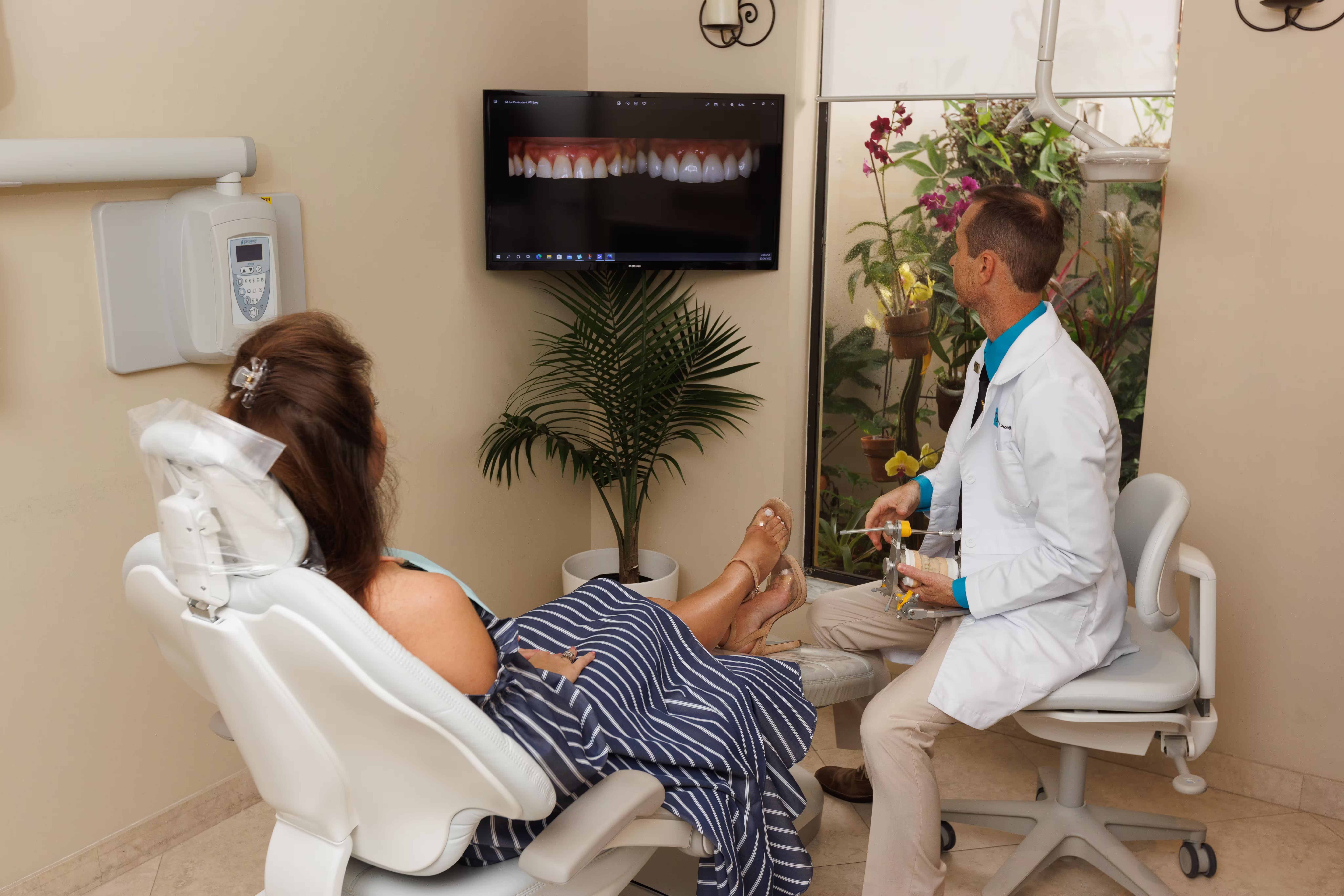Sometimes making room for teeth to fit properly is essential. For implants, orthodontics or bridges, for example, a decayed tooth that cannot be saved may have to be extracted for the purpose of restoring your mouth’s health.

When tooth pain becomes unbearable or damage is too severe to repair, extraction may be your most effective path to relief and oral health restoration. Many patients in Delray Beach find themselves facing this procedure due to severe decay, trauma, or overcrowding that threatens their overall dental wellness.
At Ocean Breeze Implant and Aesthetic Dentistry, Dr. Nicholas Goetz and Dr. Kathryn Gavalas Kaleel provide gentle, comprehensive tooth extraction services designed to minimize discomfort while protecting your long-term oral health. Our team understands that the prospect of tooth removal can feel overwhelming, which is why we prioritize clear communication and patient comfort throughout every step of the process.
Tooth extraction serves as a last resort when other treatments cannot save a damaged or diseased tooth. Several conditions may warrant this procedure, including severe tooth decay that has compromised the tooth’s structure beyond repair. Advanced gum disease can also loosen teeth to the point where extraction becomes the most viable option for preventing infection spread.
Trauma from accidents or sports injuries sometimes damages teeth so extensively that extraction offers the best path toward oral health restoration. Additionally, overcrowding in the mouth may require strategic tooth removal to create space for proper alignment, particularly before orthodontic treatment.
Wisdom teeth frequently require extraction when they become impacted or lack sufficient space to emerge properly. These third molars can cause pain, infection, and damage to surrounding teeth when left untreated.
Specialized prosthodontic treatments to restore function and beauty with financing options for complex dental care.

Modern tooth extraction techniques prioritize patient comfort and efficient healing. Before any procedure, our team conducts a thorough examination including digital X-rays to assess the tooth’s position and surrounding structures. This comprehensive evaluation allows us to develop the most appropriate extraction approach for your specific situation.
Simple extractions involve teeth that are visible above the gum line and can be removed with specialized instruments after local anesthesia. The procedure typically takes just a few minutes, and patients experience minimal discomfort during the process.
Surgical extractions may be necessary for teeth that have broken off at the gum line or remain impacted beneath the surface. These procedures require additional steps but are performed with the same attention to patient comfort and precision.
Throughout the extraction, our team monitors your comfort level and adjusts anesthesia as needed. We explain each step of the process, ensuring you feel informed and at ease during your visit.
Proper aftercare following tooth extraction significantly impacts your healing timeline and comfort level. Most patients experience some swelling and mild discomfort for a few days after the procedure, which responds well to over-the-counter pain medications and cold compresses applied to the affected area.
Protecting the extraction site becomes crucial during the first 24 to 48 hours. Avoid smoking, drinking through straws, or engaging in vigorous physical activity that could dislodge the blood clot forming in the socket. This clot serves as the foundation for proper healing and prevents complications like dry socket.
Maintaining good oral hygiene while being gentle around the extraction site promotes faster healing. Rinse carefully with warm salt water after meals, but avoid aggressive swishing that could disturb the healing process.
Most patients return to normal activities within a few days, though complete healing of the extraction site may take several weeks. Our team provides detailed aftercare instructions and remains available to address any concerns during your recovery period.
Following tooth extraction, discussing replacement options helps maintain your oral health and smile aesthetics. Dental implants offer the most comprehensive solution, replacing both the tooth root and crown with a permanent, natural-looking restoration that functions like your original tooth.
Dental bridges provide another effective option, using adjacent teeth as anchors to support a replacement tooth in the extraction site. This approach works particularly well when neighboring teeth would benefit from crowns or already have existing restorations.
Partial dentures offer a removable solution for replacing one or more extracted teeth, providing an economical option that restores basic function and appearance. Our team helps evaluate which replacement option aligns best with your oral health goals, lifestyle, and budget considerations.
Planning for tooth replacement often begins before the extraction procedure, allowing us to coordinate your treatment timeline for optimal results and minimal disruption to your daily routine.
When a tooth extraction is absolutely necessary to fix your oral conditions, pulling out an infected or decayed tooth might relive pain instantly.
Sometimes a patient may need to have a tooth removed in order to preserve the surrounding teeth, or to make room for the rest of the teeth to fit properly in the mouth.
Sometimes making room for teeth to fit properly is essential. For implants, orthodontics or bridges, for example, a decayed tooth that cannot be saved may have to be extracted for the purpose of restoring your mouth’s health.
In many cases, and if diagnosed accurately by your dentist, removing the damaged tooth might be the only way to do away with the dental problem that is affecting your mouth.
Teeth that fit properly in a mouth can make you regain the functions of your bite.
If a tooth needs to be extracted due to its damaged condition, this may bring along benefits for an enhanced smile. Teeth that fit properly can achieve an aesthetically balanced look.
Our Delray Beach practice combines advanced techniques with compassionate care to make tooth extraction as comfortable as possible. Dr. Goetz brings specialized training in complex oral rehabilitation, while Dr. Gavalas contributes extensive experience in general dentistry procedures, ensuring comprehensive care for every patient. We utilize modern anesthesia techniques and sedation options to minimize anxiety and discomfort during your procedure. Our team takes time to explain your treatment options thoroughly, helping you make informed decisions about your oral health care.
From initial consultation through complete recovery, we maintain open communication and provide the support you need for successful healing. Our commitment to patient education ensures you understand every aspect of your treatment and feel confident in your care decisions. Don’t let tooth pain compromise your quality of life. Contact Ocean Breeze Implant and Aesthetic Dentistry at (561) 265-1998 or through our contact form to schedule your consultation and take the first step toward restored oral health and comfort.
A tooth extraction is a minor surgical procedure. Therefore, it requires a couple of steps with your dentist and your oral surgeon.
Checking your oral conditions through an initial comprehensive exam is the first step. At this stage your doctor will take X-rays and check your mouth thoroughly to diagnose if the tooth extraction is the solution for your problem.
If a tooth extraction is needed, your next step will be to see the oral surgeon to proceed with the extraction.
You will be given local anesthesia since taking out a tooth can be painful without having your mouth numbed.
Once the tooth has been extracted, you will have a healing period (usually a couple of days) before your dentist can go on with any other treatment you may need, such as a bridge or an implant, for example.
The socket left in the area where the tooth was extracted will be cleaned and carefully washed so that no infection can develop in that area. In some cases, stitching up the tissues will be needed.
TOOTH EXTRACTION FAQs
**Requested time is not final until you receive confirmation from our office. Please do not submit any Protected Health Information (PHI).
"*" indicates required fields

**Requested time is not final until you receive confirmation from our office. Please do not submit any Protected Health Information (PHI).
"*" indicates required fields